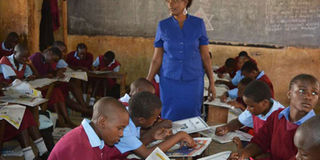Kenya receives Sh8.8bn to boost education

Class Eight pupils of Nabongo Primary School in Kakamega sit for a Kiswahili exam on March 14, 2017. PHOTO | ISAAC WALE | NATION MEDIA GROUP
What you need to know:
- According to the advert, the funding will go to 131 schools in Nakuru County and 120 in Murang’a as will 95 in Homa Bay.
- The first tranche will be given out based on the school’s categorisation following findings of the recent school-based risk audit.
A Sh8.84 billion grant has been secured to improve and strengthen education in the country.
The first tranche of Sh407 million from the Global Partnership for Education will go to 1,357 schools in 27 counties.
The multilateral partnership gives education to children in the world’s poorest nations.
A total of 4,000 schools in all 47 counties will be covered in the four-year project until March 2018 under the World Bank-supervised Kenya primary education development project (Priede).
NUMBER OF SCHOOLS
In an advertisement in the government newspaper, My.Gov on Tuesday, the schools will have to adhere to management and accountability requirements.
According to the advert, the funding will go to 131 schools in Nakuru County and 120 in Murang’a as will 95 in Homa Bay.
In Taita-Taveta, 93 schools have been singled out in the first phase and 85 in Meru.
Counties with the least schools in the first phase are Tana River, with five, Nairobi and Marsabit (12), Wajir (15) and Samburu (19).
“Each school will receive a grant of $5,000 (Sh500,000) in two tranches,” reads the ad by the Principal Secretary, State Department for Basic Education.
LITERACY LEVELS
The first tranche will be given out based on the school’s categorisation following findings of the recent school-based risk audit.
In 2016, the government distributed 4.8 million textbooks to more than 20,000 primary schools under the Tusome Project in a bid to improve literacy in Standard One and Two.
According to the ministry, eight firms have been recruited to train 4,000 school teams on school improvement plans.
About 4,000 head teachers and 8,000 boards of management have also been sensitised on teachers performance appraisal development.
Recently, Education Principal Secretary Belio Kipsang said private schools will be included in Tusome and Priede.
“As we prepare to print the second copies of the book of Priede, we want to see how we can work with you and how children in our private schools will benefit from the methodology and contents from the curriculum delivered from these concepts,” said Dr Kipsang at the close of the 20th annual conference for private school managers in Mombasa.
Kenya Private Schools Association chairperson Mutheu Kasanga had complained that private schools had been unfairly left out of the two developments.





